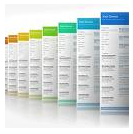Enter the 4th generation of PPC Landing policies. This rolls-up the benefits of single-focus Landing and Deep-link pages. The entrance point from PPC traffic is largely the same as dedicated landing pages but this page is supported by a number of other pages; all focussed around converting the visitor. There are two main approaches used in the creation of Landing Microsites.
Conversion support microsites
These are designed around a single conversion objective, such as acquiring an email address and name. The supporting pages are created to address any of the classic barriers to conversion and vary widely from market to market. Typical barriers to first-page conversion can include:
1. Uncertainty that the site is right for the visitor.
2. Fear that leaving information on the site might start a spam cycle.
3. Unreadiness to move along the sales cycle at the this time.
4. Concerns about the reputation and quality of the company operating the site.
5. Time to complete the conversion process.
6. Inappropriate call-to-action that is not relevant to the visitor.
It’s not just barriers that need to be covered; the visitor may simply not have enough information about your organisation yet. For example, they may not know whereabout you are and how far away you are.
In supporting the conversion the additional pages must address the relevant issues and attempt to bridge the gap between thinking about converting to converting. As the needs in each sector vary wildly I won’t go into detail about how you might address the supporting pages. If you want to have an informal chat about how to go about uncovering the issues and how you might address them then please do give me a call on 0845 051 4228 or email me.
Here is a simple example of dealing with a very common barrier to conversion; item 2 – fear of a spam cycle. Assuming that your organisation is ethical, open and doesn’t plan to spam visitors then a good supporting page would be “we value your privacy – learn more about what we do with the details you leave“. This page should start in simple tones explaining what happens next, why and when. Further down the page you should then delve deeper into your privacy policy and then finally the page should finish off with the formal Data Protection policy.
Critically, the page needs to be interspersed with opportunities to convert; not everyone will need to read the whole page before they are satisfied that you are not a spammer.
Cascading conversion microsites
 For many organisations there are various different levels of conversion and furthermore very few organisations have a 1 step sales process. This raises the possibility of attempting multiple conversions in and around a microsite. The simplest way I can visualise this is by imagine taking your existing web-site and strip out all the pages and content that are NOTdesigned to convert and then add back in the supporting pages as found in a conversion support microsite.
For many organisations there are various different levels of conversion and furthermore very few organisations have a 1 step sales process. This raises the possibility of attempting multiple conversions in and around a microsite. The simplest way I can visualise this is by imagine taking your existing web-site and strip out all the pages and content that are NOTdesigned to convert and then add back in the supporting pages as found in a conversion support microsite.
By way of example, your organisation’s conversion points may consist of:
1. Sign-up for special offers/newsletter; requiring email address only.
2. Find a place/venue/office/clinic/park; requiring a postcode only and maybe an email address.
3. Request information; requiring name, address (if physically posted), email, inside leg measurement and gender.
4. Book an event/meeting/space/place/call. This would typically require a great deal of information.
5. Contact us; maybe only needing an email address and a message.
6. Call me back; would require a name and a telephone number.
Each of the above conversion points gathers different data, raises different questions with the visitor and has different outcomes. In the example above I would suggest the most valuable would be 4 and the least valuable would be 1 or 2. Certainly, the visitor motivation difference between them is great and could be addressed using a cascade conversion approach.
Knowing that visitors become more predisposed to leave information the longer they interact typically you would want to start the microsite with the lightest touch conversion, maybe a simple sign-up should be the primary call-to-action. There should be links to other conversion pages but the key here is getting the visitor to interact early on and it’s easy to leave an email address to sign-up for special offers.
The next stage is to cascade the next conversion points into the back of the previous one. What this means in real terms is that the thanks page for the first conversion is the second conversion point and in turn down the line ending up with the last thanks page as the book an event/place. To make this work whatever system you use to deliver the cascade pages must be able to remember what stage the visitor is at since many don’t convert on first visit and will return again and again.
So what we have now is a process whereby the visitor is nudged gently along the sales cycle with ever increasing momentum. By the time they are converting on the last stage they are mentally conditioned to simple move along to the next stage.

